Study of Hot-Dip Aluminium Plating Based on Micro-Morphology and Coating Bond Strength
Abstract
:1. Introduction
2. Experimental Materials and Methods
2.1. Experimental Materials
2.2. Preparation of Hot-Dip Aluminium Layers
3. Results and Discussion
3.1. Micro-Morphological Observation of Hot-Dip Aluminium Coatings
3.2. Effect of Different Dip-Plating Parameters on the Microstructure of Coatings
3.2.1. Effect of Dip-Plating Temperature on the Microstructure of Coatings
3.2.2. Effect of Dip-Plating Times on the Microstructure of Coatings
3.2.3. Effect of the Addition of Rare Earth Oxides on the Microstructure of Coatings
3.3. Bonding Strength of Hot-Dip Aluminium Coatings
4. Conclusions
- (1).
- The coating after hot-dip aluminium plating consists of an aluminium-rich layer on the outside and a Fe-Al alloy layer on the inside, with the aluminium-rich layer uniformly distributed on the surface of the white needle-like FeAl3 phase and the iron–aluminium alloy layer mainly consisting of the serrated Fe2Al5 phase and a small amount of FeAl3 phase at the junction with the aluminium-rich layer.
- (2).
- With an increase in dip plating temperature, the surface FeAl3 phase increases and then decreases. The fluidity of the aluminium solution increases, and the thickness of the aluminium-rich layer decreases while causing defects such as leakage and pinholes. At the same time, the increase in temperature leads to accelerated diffusion of Fe and Al atoms, and the thickness of the intermediate alloy layer increases.
- (3).
- With the extension of the dip-plating time, the size and quantity of the FeAl3 phase on the surface decrease, and the surface oxidation, cavities, and other defects increase, but the thickness of the aluminium-rich layer does not change much. The Fe2Al5 phase grows to the steel matrix in a tooth-like manner, the thickness of the Fe-Al alloy layer increases, and the demarcation line between the Fe-Al alloy layer and the aluminium-rich layer is more and more obvious and straight.
- (4).
- With an increase in the addition of rare earth oxides, the size of the FeAl3 phase on the surface decreases and then increases, and the FeAl3 layer shows a tendency to thicken and then thin, and the aluminium-rich layer gradually thickens. At first, the Al-rich layer and the alloy layer became smooth and flat, and the morphology was better when the addition amount of rare earth oxides was 0.5%, and with the further increase in the addition amount, the defects such as holes and looseness in the coating layer increased significantly.
- (5).
- The bonding strength of the coating is closely related to its microscopic morphology and melt fluidity. At different dip plating temperatures and dip plating times, the bonding strength of the coatings showed a continuous decrease or an increase followed by a decrease. The steel substrate at a dip coating temperature of 700 °C, dip coating time of 5 min obtained after the coating interface is good, the thickness is moderate, the bonding strength of 49 N, the best overall performance.
Author Contributions
Funding
Institutional Review Board Statement
Informed Consent Statement
Data Availability Statement
Conflicts of Interest
References
- Tian, X.; Pei, J.J. Study progress on the pipeline transportation safety of hydrogen-blended natural gas. Heliyon 2023, 9, e21454. [Google Scholar] [CrossRef] [PubMed]
- Ohaeri, E.; Eduok, U.; Szpunar, J. Hydrogen related degradation in pipeline steel: A review. Int. J. Hydrogen Energy 2018, 43, 14584–14617. [Google Scholar] [CrossRef]
- Wang, T.S.; Pu, J.; Bo, C.; Jian, L. Sol–gel prepared Al2O3 coatings for the application as tritium permeation barrier. Fusion Eng. Des. 2010, 85, 1068–1072. [Google Scholar] [CrossRef]
- Wang, L.; Yang, J.J.; Liang, C.H.; Feng, Y.J.; Jin, W.; Cao, J.L.; Wang, X.Y.; Feng, K.M.; Kleyn, A.W.; Liu, N. Preparation and properties of improved Al2O3 based MOD coatings as tritium permeation barrier. Fusion Eng. Des. 2019, 143, 233–239. [Google Scholar] [CrossRef]
- Yang, F.L.; Xiang, X.; Lu, G.D.; Zhang, G.K.; Tang, T.; Shi, Y.; Wang, X.L. Tritium permeation characterization of Al2O3/FeAl coatings as tritium permeation barriers on 321 type stainless steel containers. J. Nucl. Mater. 2016, 478, 144–148. [Google Scholar] [CrossRef]
- Zhang, G.K.; Wang, X.L.; Xiong, Y.F.; Shi, Y.; Song, J.F.; Luo, D.L. Mechanism for adsorption, dissociation and diffusion of hydrogen in hydrogen permeation barrier of α-Al2O3: A density functional theory study. Int. J. Hydrogen Energy 2012, 38, 1157–1165. [Google Scholar] [CrossRef]
- Abro, M.A.; Hahn, J.; Lee, D.B. High Temperature Oxidation of Hot-Dip Aluminized T92 Steels. Met. Mater. Int. 2018, 24, 507–515. [Google Scholar] [CrossRef]
- Zhang, J.D.; Yin, Y.S.; Li, J.; Zhang, H. Fabrication and properties of Fe3Al–Al2O3 graded coatings. J. Mater. Process. Technol. 2003, 134, 206–209. [Google Scholar] [CrossRef]
- Huang, J.; Xie, H.; Luo, L.-M.; Zan, X.; Liu, D.-G.; Wu, Y.-C. Preparation and properties of FeAl/Al2O3 composite tritium permeation barrier coating on surface of 316L stainless steel. Surf. Coat. Technol. 2020, 3831, 125282. [Google Scholar] [CrossRef]
- Han, S.L.; Li, H.L.; Wang, S.M.; Jiang, L.J.; Liu, X.P. Influence of silicon on hot-dip aluminizing process and subsequent oxidation for preparing hydrogen/tritium permeation barrier. Int. J. Hydrogen Energy 2010, 35, 2689–2693. [Google Scholar] [CrossRef]
- He, Y.F.; Guo, E.K.; Zhong, F.; Fu, B.W.; Cai, G.-X.; Zhang, D.X.; Jiang, C.Z.; Ren, F. A novel method for preparing α-Al2O3 (Cr2O3)/Fe–Al composite coating with high hydrogen isotopes permeation resistance. Ceram. Int. 2024, 50, 20367–20375. [Google Scholar] [CrossRef]
- Wang, B.Y.; Sun, X.Y.; Liu, E.Y.; Liu, L.; Ma, W.J.; Shi, Y.-Z.; Huang, P.; Luo, Y. Preparation and Hydrogen Barrier Property of FexAly/Al/Al2O3 Composite Coating on X80 Steel Surface. Met. Mater. Int. 2024, 30, 77–78. [Google Scholar] [CrossRef]
- Liu, J.G.; Bi, H.S.; Zhang, Q.S.; Liu, S.Q.; Li, H.W.; Cui, G. Design, fabrication, and hydrogen blocking performance of alumina/zirconia functional gradient coatings. Ceram. Int. 2024. [Google Scholar] [CrossRef]
- Eggeler, G.; Vogel, H.; Friedrich, J.; Kaesche, H. Zielpräparation zum transmissionselektronenmikroskopischen Nachweis der Phase Al3Fe (θ-Phase) auf tauchaluminiertem, niedriglegiertem Stahl/Target Preparation for the Transmission Electron Microscopic identification of the Al3Fe (θ-Phase) in Hot-Dip Aluminised Low Alloyed Steel. Pract. Metallogr. 1985, 22, 163–170. [Google Scholar]
- Xiang, X.; Yang, F.L.; Zhang, G.K.; Wang, X.L. Effect of Steel Substrates on the Formation and Deuterium Permeation Resistance of Aluminide Coatings. Coatings 2019, 9, 95. [Google Scholar] [CrossRef]
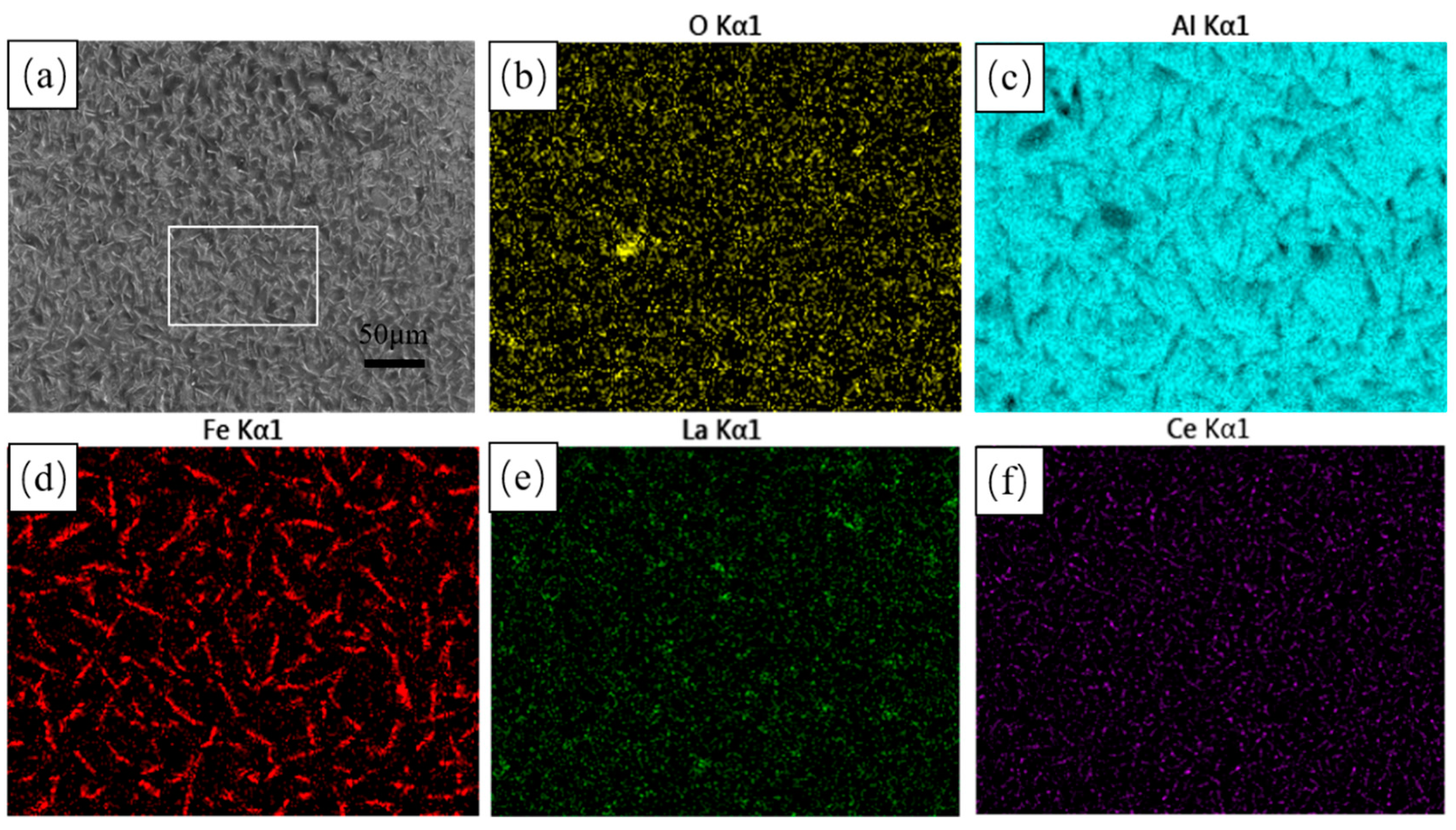
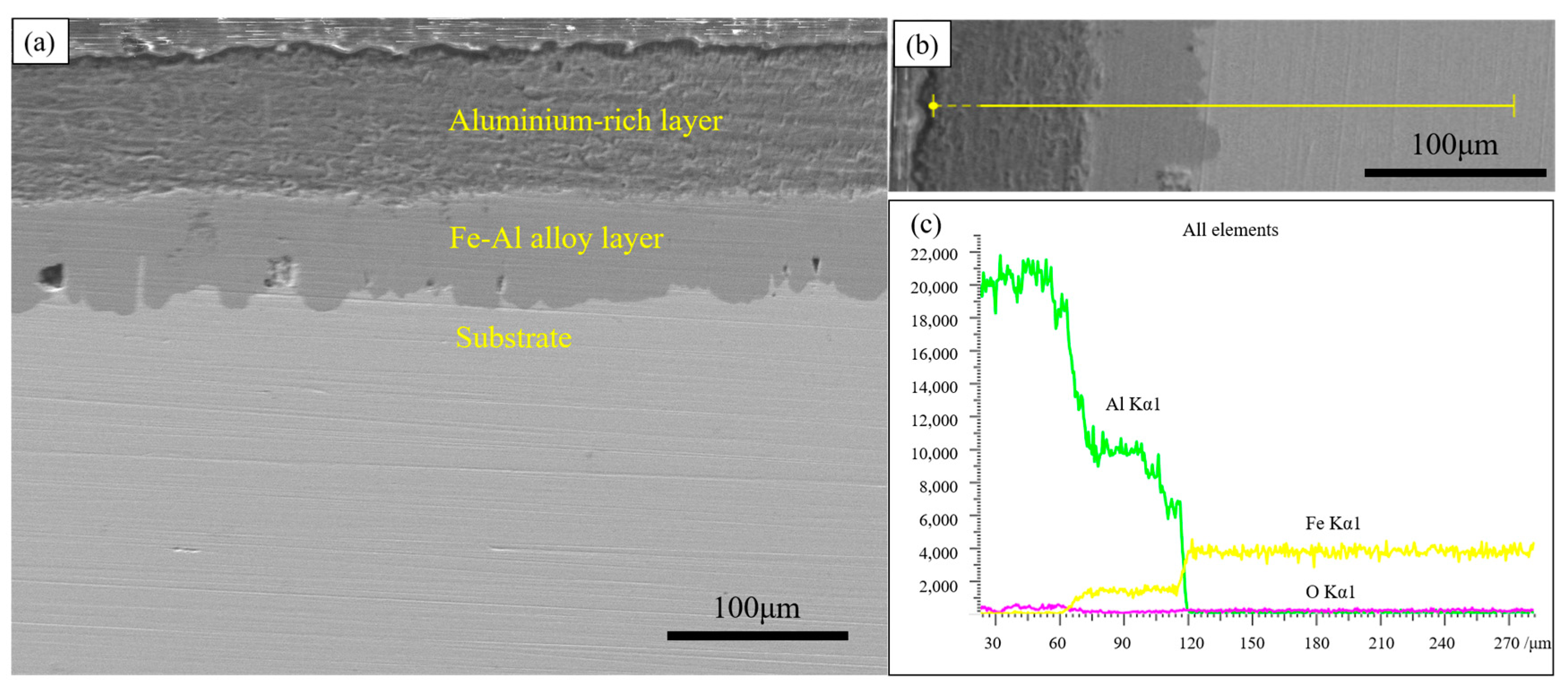

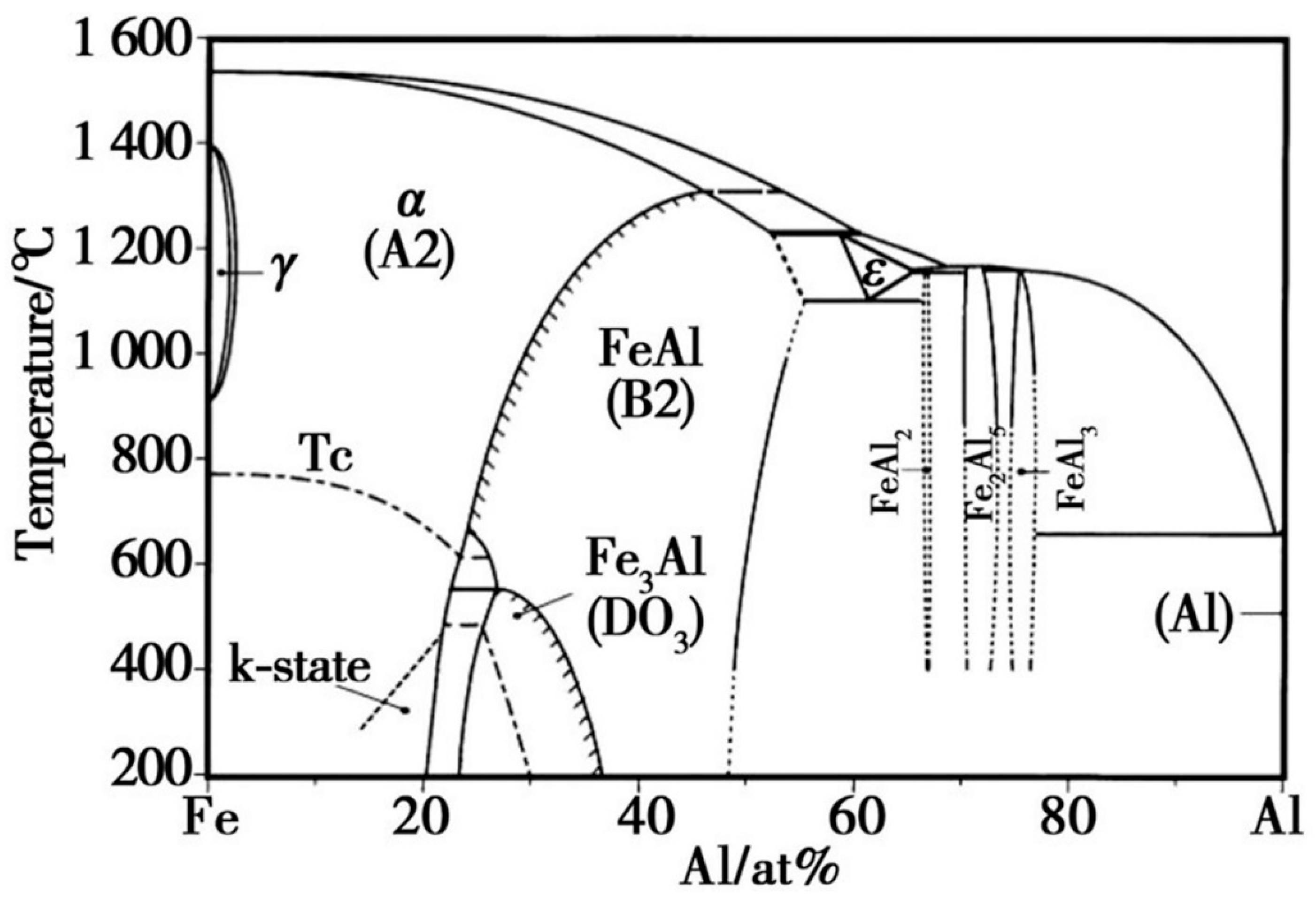

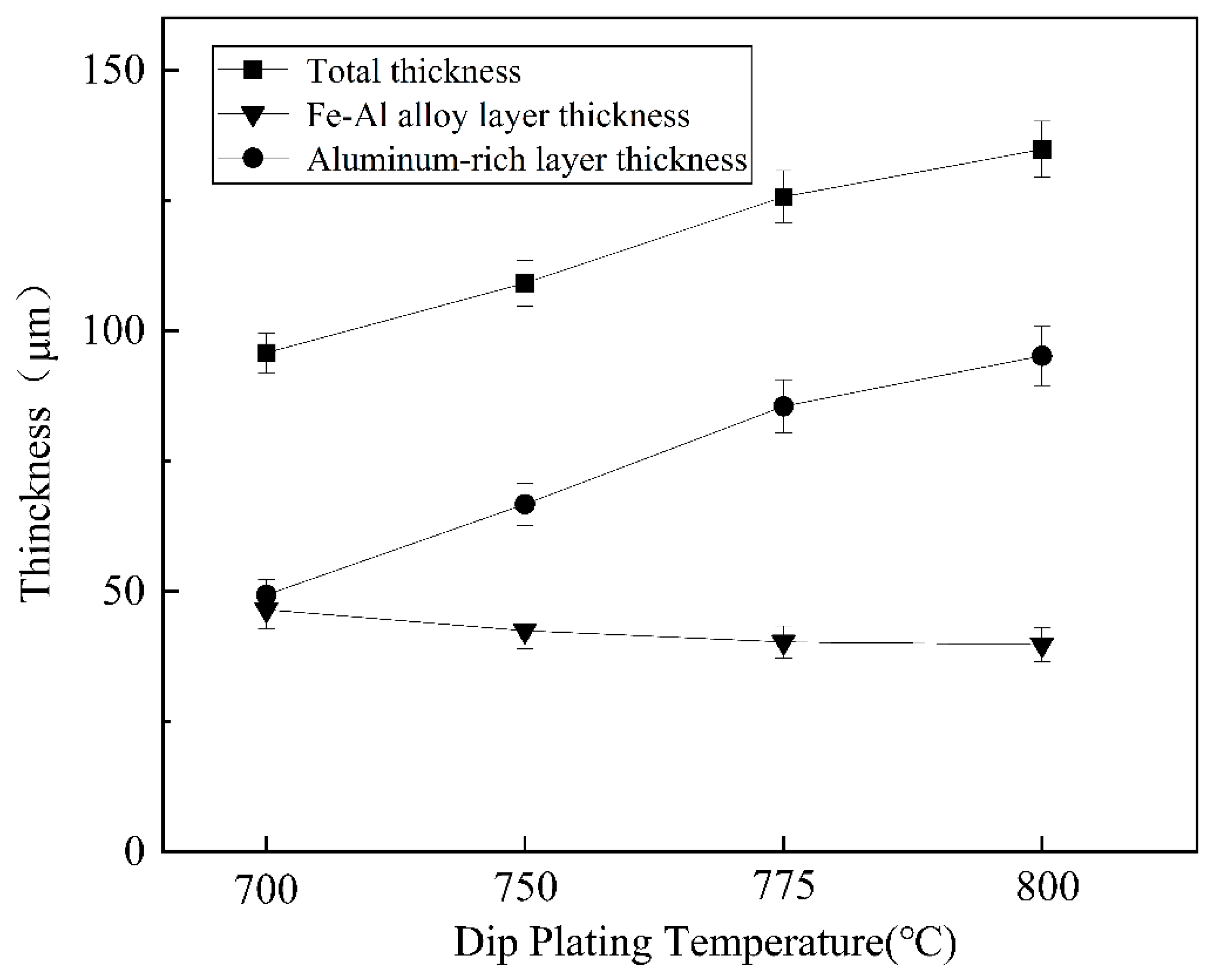

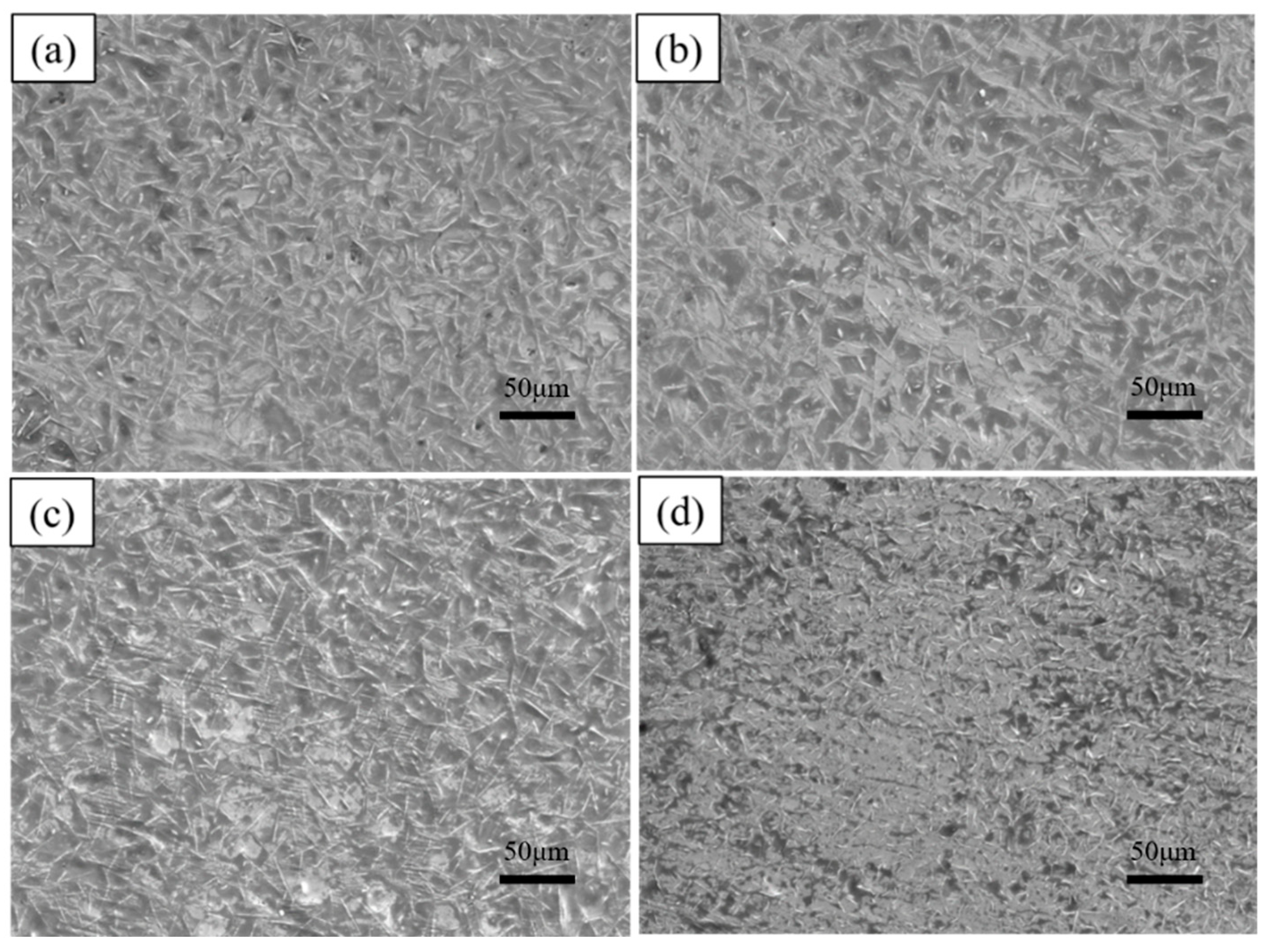



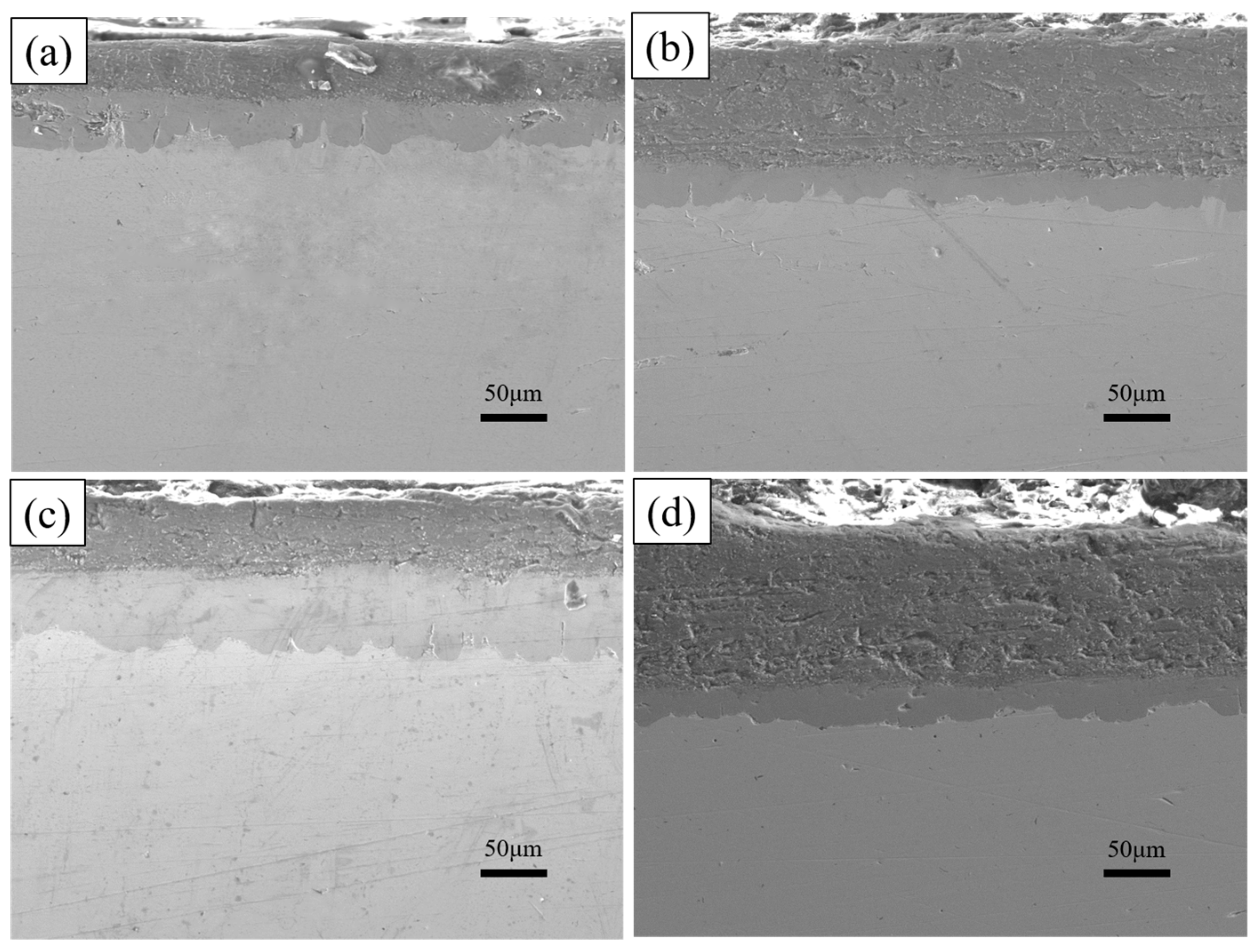
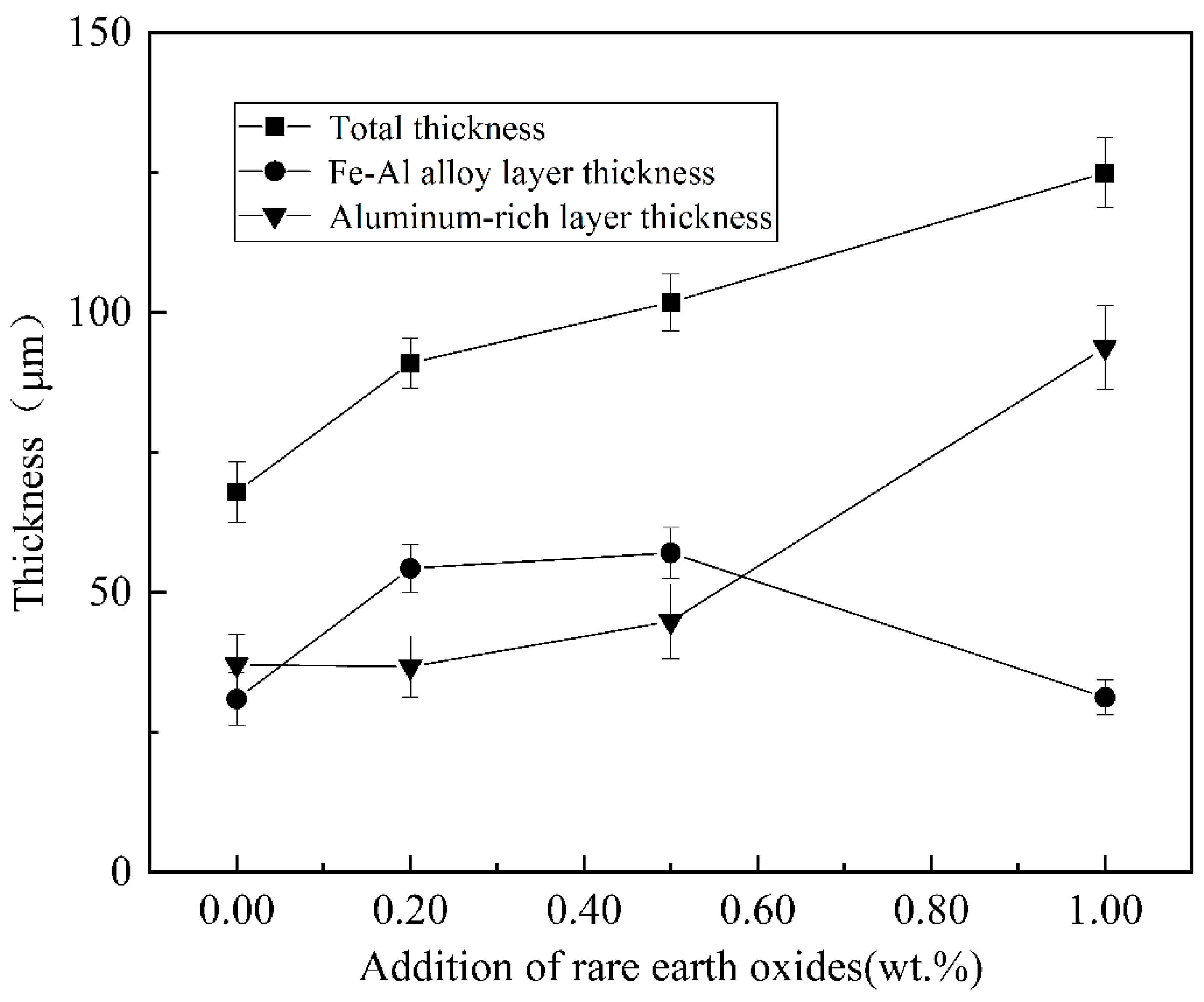
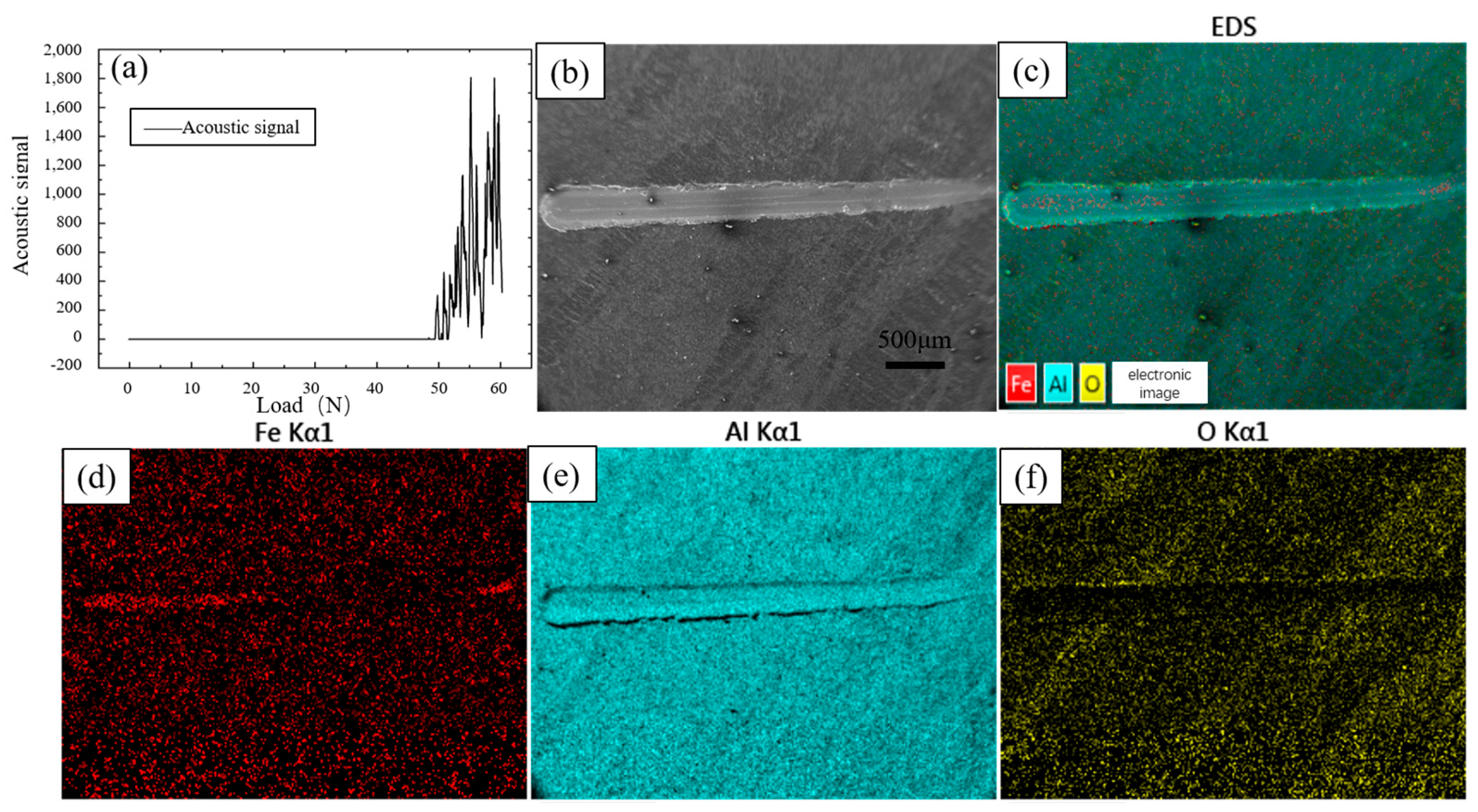

| Element | C | Mn | Si | P | Cu | Cr | Mo | Ni | Nb | V | Ti | Fe |
|---|---|---|---|---|---|---|---|---|---|---|---|---|
| Content | 0.058 | 1.57 | 0.20 | 0.013 | 0.09 | 0.024 | 0.23 | 0.2 | 0.050 | 0.035 | 0.013 | Balance |
| Dip Plating Temperature/°C | Dip Plating Time/min | Auxiliary Plating Agent/wt.% | Amount of Rare Earth Added/wt.% |
|---|---|---|---|
| 700 | 5 | 6%KF + 2%ZnCl2 | 0.5 |
| 750 | |||
| 775 | |||
| 800 |
| Dip Plating Temperature/°C | Dip Plating Time/min | Auxiliary Plating Agent/wt.% | Amount of Rare Earth Added/wt.% |
|---|---|---|---|
| 700 | 2 | 6%KF + 2%ZnCl2 | 0.5 |
| 5 | |||
| 10 | |||
| 15 |
| Dip Plating Temperature/°C | Dip Plating Time/min | Auxiliary Plating Agent/wt.% | Amount of Rare Earth Added/wt.% |
|---|---|---|---|
| 700 | 5 | 6%KF + 2%ZnCl2 | 0 |
| 0.2 | |||
| 0.5 | |||
| 1 |
Disclaimer/Publisher’s Note: The statements, opinions and data contained in all publications are solely those of the individual author(s) and contributor(s) and not of MDPI and/or the editor(s). MDPI and/or the editor(s) disclaim responsibility for any injury to people or property resulting from any ideas, methods, instructions or products referred to in the content. |
© 2024 by the authors. Licensee MDPI, Basel, Switzerland. This article is an open access article distributed under the terms and conditions of the Creative Commons Attribution (CC BY) license (https://creativecommons.org/licenses/by/4.0/).
Share and Cite
Zhang, C.; Wang, B.; Sun, X.; Liu, L.; Liu, E.; Guo, H.; Yin, L.; Yang, J.; Ma, J. Study of Hot-Dip Aluminium Plating Based on Micro-Morphology and Coating Bond Strength. Coatings 2024, 14, 1257. https://doi.org/10.3390/coatings14101257
Zhang C, Wang B, Sun X, Liu L, Liu E, Guo H, Yin L, Yang J, Ma J. Study of Hot-Dip Aluminium Plating Based on Micro-Morphology and Coating Bond Strength. Coatings. 2024; 14(10):1257. https://doi.org/10.3390/coatings14101257
Chicago/Turabian StyleZhang, Chen, Bingying Wang, Xiaoyong Sun, Lin Liu, Enyang Liu, Haodong Guo, Lu Yin, Junze Yang, and Jialei Ma. 2024. "Study of Hot-Dip Aluminium Plating Based on Micro-Morphology and Coating Bond Strength" Coatings 14, no. 10: 1257. https://doi.org/10.3390/coatings14101257
APA StyleZhang, C., Wang, B., Sun, X., Liu, L., Liu, E., Guo, H., Yin, L., Yang, J., & Ma, J. (2024). Study of Hot-Dip Aluminium Plating Based on Micro-Morphology and Coating Bond Strength. Coatings, 14(10), 1257. https://doi.org/10.3390/coatings14101257







